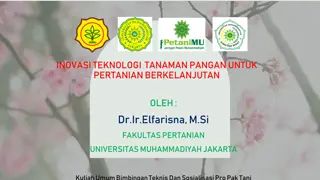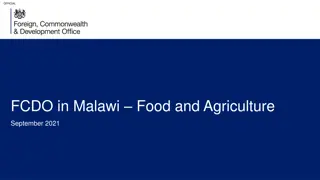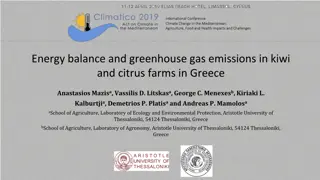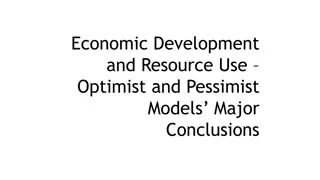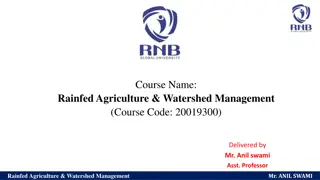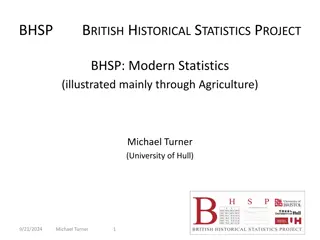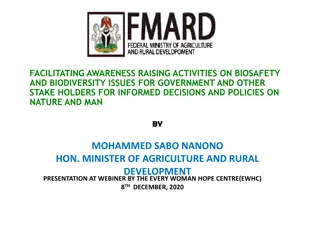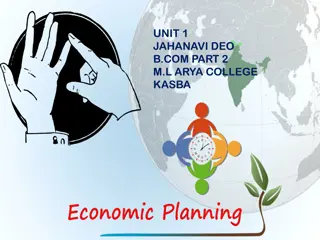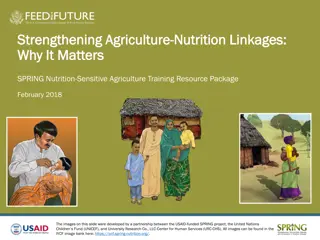The Future of Agriculture: A Pessimistic View
The agriculture sector has shown fluctuations in growth rates over the years, with mixed trends in investment and credit. Despite some revival, challenges like dependence on rain-fed areas and disparities in regions persist. The increase in agricultural credit has not equally benefitted all farmers. However, the rise in Minimum Support Price (MSP) has provided some relief to farmers. The future of agriculture seems uncertain with a pessimistic viewpoint presented.
Download Presentation

Please find below an Image/Link to download the presentation.
The content on the website is provided AS IS for your information and personal use only. It may not be sold, licensed, or shared on other websites without obtaining consent from the author.If you encounter any issues during the download, it is possible that the publisher has removed the file from their server.
You are allowed to download the files provided on this website for personal or commercial use, subject to the condition that they are used lawfully. All files are the property of their respective owners.
The content on the website is provided AS IS for your information and personal use only. It may not be sold, licensed, or shared on other websites without obtaining consent from the author.
E N D
Presentation Transcript
Where is Agriculture headed?: A Pessimistic View Himanshu JNU
GDP has grown at more than 5% since the mid-1980s. The acceleration in growth rates to more than 9% since 2005-06 was short lived with growth rates slowing down in the last 2 years. 2
This was also accompanied by revival of agricultural growth rates in the later part of last decade. However, 60% of cultivated area is rain- fed and there are disparities across region and crop. 3
Agrarian Revival since 2005 Revival since 2004-05 after the worst crisis during 1997-2004 Agricultural growth rate picked up: more than 3.5% after 2004-5 Agricultural investment picked up Agricultural credit quadrupled Good monsoon TOT moving in favour of agriculture
Public Investment in Agriculture picked up after 2003-04 (1999-00 constant prices) Public Investment in Agriculture (constant prices) 25000 20000 15000 10000 5000 0 Public Investment in Agriculture (constant prices)
Private investment in agriculture grew faster with share of public investment remaining unchanged.
Agricultural credit which was almost stagnant until 2003, picked up dramatically and quadrupled by 2012 Agricultural Credit Disbursed 600000 500000 400000 300000 200000 100000 0
Not all the credit benefitted the farmers, particularly the small and marginal farmers. some indicators of credit from SAS 60 51.9 48.6 47 50 42.3 40.2 40 30 25.8 25.7 20 12.585 10 0 % farmers indebted Average outstanding Share of informal sector Share of money lenders loan('000) 2002-03 2012-13
The increase in MSP also benefitted the farmers. The margin of MSP over cost continued to increase MSP Fixed C2 Cost % Margin over C2 Year Paddy Wheat Paddy Wheat Paddy Wheat 2006-07 569 542 650 700 14 29 2007-08 595 574 775 850 30 48 2008-09 619 624 930 1000 50 60 2009-10 645 649 1030 1080 60 66 2010-11 742 701 1030 1100 39 57 2011-12 888 826 1110 1170 25 42
This is true irrespective of cost concept used. t1 (Average during 2000- 01 to 2003-04) t2 (Average during 2004-05 to 2007-08) t3 (Average during 2008-09 to 2010-11) Gross Margins over MSP as % of (A2+FL) cost 66 Net Margins over MSP as % of C2 cost 19 Gross Margins over MSP as % of (A2+FL) cost Gross Margins over MSP as % of (A2+FL) cost Net Margins over MSP as % of C2 cost Net Margins over MSP as % of C2 cost Crops Cereals 57 7 11 84 1 Paddy 49 5 58 8 67 13 2 Wheat 96 25 103 28 133 38 3 Maize 10 -20 33 -11 49 6 4 Bajra 17 -14 32 -6 58 11 5 Barley 55 15 82 3 75 13
It also meant that agricultural sector benefitted from the relative shift in terms of trade towards agricultural commodities with food prices rising faster than manufactured goods. 11
This was also transmitted to wage workers with acceleration in growth rate of wages. Rural real wages increased at more than 6% per annum between 2008 and 2013. 12
The increase in wage rates also meant rising cost of cultivation
Cash cost is increasing faster since 2009, mainly labour, diesel and fertiliser
The introduction of NBS did help contain the fertiliser subsidy, largely because of the decline in P&K subsidy Fertiliser Subsidy 120000 100000 80000 60000 40000 20000 0 2005-06 2006-07 2007-08 2008-09 2009-10 2010-11 2011-12 2012-13 2013-14 2014-15 (BE) Subsidy on P&K Subsidy on Urea Total subsidy outgo
But it was also accompanied by increasing fertiliser prices. DAP Price 30000 25000 20000 15000 10000 5000 0 I II III IV I II III IV I II III IV I II III IV 10-11(Qtr. Wise) 11-12(Qtr. Wise) 2012-13(Qtr. Wise)2013-14 (Qtr. Wise)
The result was decline in fertiliser consumption Fertiliser Consumption 600 550.63 536.96 497.17 492.55 477.61 500 470.64 400 304.54 301.61 294.78 282.23 300 266.42 264.48 255.85 254.73 232.69 211.19 190.94 200 166.1 100 0 2008-09 2009-10 2010-11 2011-12 2012-13 2013-14 All Fertilizers (Urea, DAP,MOP & NPK) UREA P&K Fertilizers (DAP,MOP &NPK)
It also led to worsening of fertiliser mix NPK Ratio 9 8.2 8 6.7 7 6 4.7 5 4.3 4 3.2 3.1 3 2.3 2 2 1 1 1 1 1 0 2009-10 2010-11 2011-12 2012-13 N P K
The NBS did not increase domestic production of fertilisers Fertiliser production and import 30000 25000 20000 15000 10000 5000 0 2003-04 2004-05 2005-06 2006-07 2007-08 2008-09 2009-10 2010-11 2011-12 2012-13 Production Imports Consumption
The future: The golden period of Indian agriculture is headed for difficult times. International commodity prices have started declining since the later half of this year Credit flow to agriculture has stagnated Public investment in agriculture has stagnated MSP policy and WTO obligations may lead to lower procurement
World food prices are declining FAO Food Index 220.0 200.0 180.0 160.0 140.0 120.0 100.0 4/2011 1/2012 10/2012 1/2007 4/2007 7/2007 10/2007 1/2008 4/2008 7/2008 10/2008 1/2009 4/2009 7/2009 10/2009 1/2010 4/2010 7/2010 10/2010 1/2011 7/2011 10/2011 4/2012 7/2012 1/2013 4/2013 7/2013 10/2013 1/2014 4/2014 7/2014 10/2014 Food Cereal
Although not so clear in Indian case, cash crops have already seen price collapse: Cotton, Sugarcane, basmati WPI Index 290.0 270.0 250.0 230.0 210.0 190.0 170.0 150.0 All Commodities Food Articles Cereals Cotton Petrol
If the present trend continues, the following will further add to the misery in agriculture Continued volatility in the fuel (oil) prices continue to put pressure on agricultural commodity prices Increasing urbanisation as well as demand by the non- farm sector is putting pressure on agricultural land The overall deflationary policies and growth fetishism will be the obstacle in increasing investment in agriculture. With agriculture being open to international trade, it is no longer insulated to international price volatilites. The entry of finance capital in lucrative cash crop business has meant a weakening of domestic trade measures in protecting farmers
What to expect in future Urea prices likely to be increased Diesel prices likely to remain high International prices likely to stay low Fear of high fiscal deficits likely to put pressure on agricultural investments as well as food, fertiliser and other subsidies Unlikely that demand increases domestically or internationally With wage rates stagnating and decline in flow of funds to rural areas, rural areas may see an increase in distress




